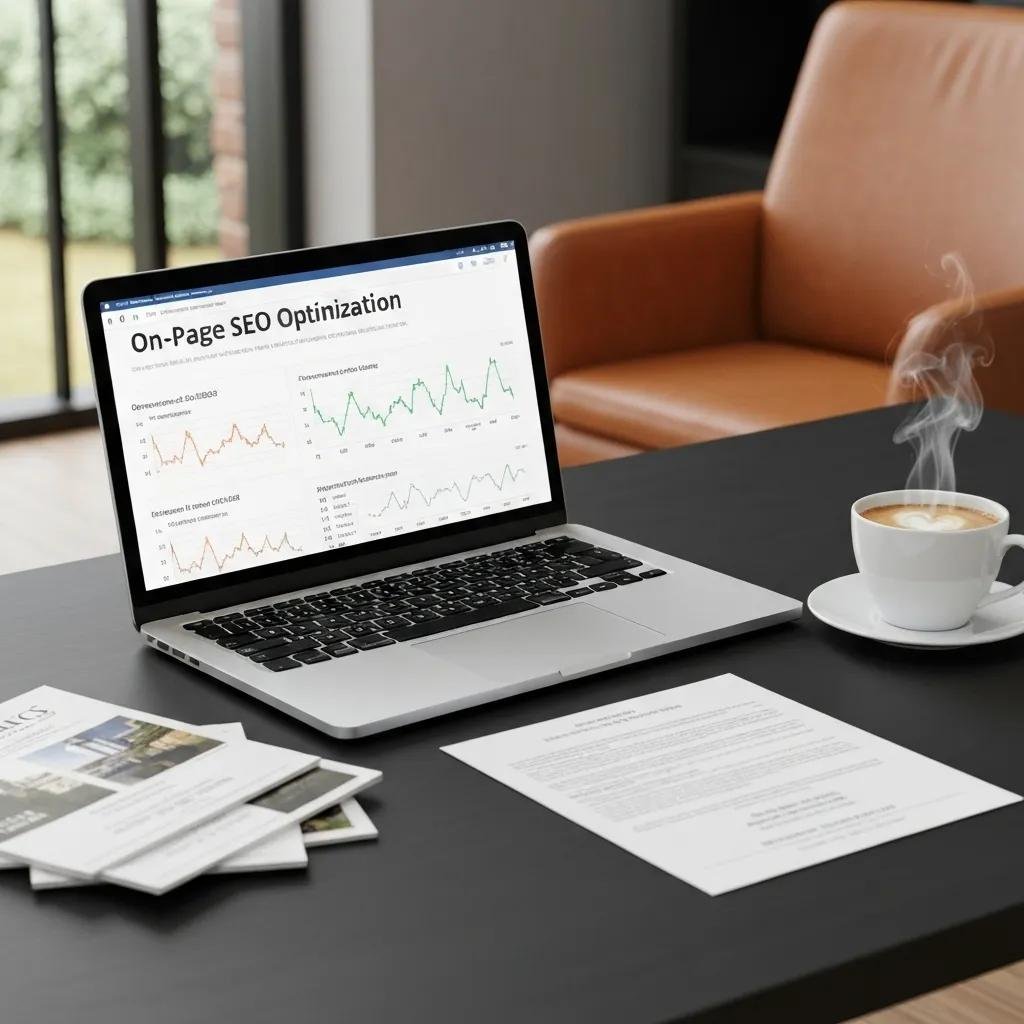
Maximize Rankings and Traffic with On-Page SEO Techniques
Organic search drives over 53 percent of all website traffic, making on-page SEO optimization techniques a critical lever for visibility and qualified leads. Homeowners facing foreclosure, divorce, inherited properties, or urgent relocations need fast solutions—and a high-ranking page on “sell my house fast” queries delivers those leads directly. In this guide, you’ll discover how to craft title tags and meta descriptions that boost click-through rates, deploy strategic keyword placement and header structure, enhance content quality, optimize images, build internal links, refine URL architecture, implement structured data, accelerate mobile page speed, reinforce E-E-A-T signals, and tailor every element for real estate investors seeking cash offers. Each section answers a key question, offers actionable steps, and shows how these techniques support SellMyHousePro.com’s promise of a fast, hassle-free cash sale.
What Are the Most Effective On-Page SEO Techniques for Maximum Impact?
On-page SEO refers to optimizing individual web pages to rank higher and earn more relevant traffic through content and HTML source code adjustments. By aligning title tags, content, technical elements, and user experience factors, on-page tactics improve visibility, drive organic clicks, and deliver qualified homeowner leads. Key techniques include:
- Title Tags & Meta Descriptions – Craft compelling snippets to influence CTR.
- Keyword Placement – Map user intent into URLs, headers, and the first 100 words.
- Content Quality – Deliver comprehensive, authoritative text that satisfies search intent.
- Header Tags – Structure content with H1–H6 for semantic clarity.
- URL Structure – Use short, keyword-rich, hyphenated URLs.
- Image SEO – Write alt text, name files descriptively, and compress images for speed.
- Internal Linking – Connect pages with descriptive anchor text to boost topical authority.
- Structured Data – Add schema to unlock rich snippets.
- Mobile & Page Speed – Ensure Core Web Vitals compliance for better rankings.
- E-E-A-T Factors – Showcase expertise, authority, and trust through author bios, testimonials, and secure site protocols.
These foundational elements set the stage for deeper optimization in each area.
The Effectiveness Of Search Engine Optimization (SEO) In Marketing: A Meta-Analysis Study
A meta-analysis of studies conducted between 2022 and 2024 revealed that implementing SEO consistently leads to a significant increase in organic search rankings and website traffic. The study identified content quality, keyword optimization, and backlinks as key factors influencing SEO effectiveness.
This research provides empirical evidence supporting the article’s foundational premise that on-page SEO techniques, including content and keyword optimization, are crucial for improving website visibility and driving traffic.
How Do Title Tags and Meta Descriptions Influence SEO Performance?
Title tags define a page’s clickable headline on SERPs, while meta descriptions summarize its content beneath the title. When well-optimized, title tags containing primary keywords and meta descriptions featuring a clear call to action can increase click-through rate by up to 30 percent, directly boosting organic traffic and lead volume. Properly formatted title tags (<60 characters) and meta descriptions (150–160 characters) influence both ranking signals and user engagement, forming the gateway to on-page relevance and conversions. Understanding their role lays the groundwork for crafting high-impact snippets that attract homeowners ready to sell quickly.
4 SEO Tips to Boost Click-Through Rate
Click-through rate (CTR) is a pivotal SEO metric that quantifies user engagement and is utilized as a ranking signal by search engines. Optimizing metadata, such as creating compelling title tags and meta descriptions, is highlighted as a strategic improvement that can significantly increase clicks and maximize overall SEO efforts.
This directly supports the article’s section on how well-optimized title tags and meta descriptions can boost CTR, organic traffic, and lead volume by influencing both ranking signals and user engagement.
Why Is Keyword Placement Critical for On-Page SEO Success?
Keyword placement signals content relevance to search engines and guides users immediately to the page’s purpose. Embedding primary keywords in the URL, the first 100 words of content, H1 and H2 tags, and image alt text reinforces semantic associations that improve rankings for targeted queries like “sell my house fast.” Proper distribution prevents keyword stuffing while ensuring search bots understand topic focus and homeowners find precise solutions. Consistent placement across these on-page elements creates a coherent user journey from search result to conversion form.
How Does Content Quality Affect User Experience and Rankings?
High-quality content satisfies both search intent and user expectations by combining depth, clarity, and authoritative insights. Pages exceeding 2,000 words often earn 3.5× more backlinks and generate longer dwell times, signaling value to search engines and enhancing ranking potential. Integrating statistics, real-estate examples (e.g., quick-sale case studies), and clear formatting (short paragraphs, bullet points) fosters trust and conversion—crucial for distressed homeowners seeking straightforward cash offers. Superior content quality thus drives engagement and supports SellMyHousePro.com’s credibility.
What Role Do Header Tags Play in Structuring SEO Content?
Header tags (H1–H6) establish a clear hierarchy that search engines and readers use to navigate content.
| Heading Level | Purpose | Best Practice |
|---|---|---|
| H1 | Main page topic | Single, keyword-rich title |
| H2 | Major sections | Incorporate secondary keywords |
| H3–H6 | Subsections and details | Break content into digestible, themed segments |
Proper header use enhances semantic clarity, improves accessibility, and enables featured-snippet eligibility by signaling key concepts to crawlers and readers. Crafting a logical header structure also sets the stage for advanced internal linking and topic clustering.
How to Optimize Title Tags and Meta Descriptions for Higher Click-Through Rates?

Optimizing title tags and meta descriptions begins with aligning keywords to search intent and crafting persuasive, action-oriented copy. A succinct title and compelling description invite clicks from homeowners who need fast cash offers, improving lead generation and reinforcing brand value.
What Are the Best Practices for Crafting SEO-Friendly Title Tags?
Title tags should:
- Remain under 60 characters to avoid truncation.
- Place primary keywords at the beginning for maximum weight.
- Include branding (SellMyHousePro.com) at the end for recognition.
- Use vertical bars or hyphens for readability.
Implementing these guidelines ensures each title tag both ranks well and drives homeowner engagement.
How Can Meta Descriptions Be Written to Maximize User Engagement?
Meta descriptions must:
- Summarize page benefits in 150–160 characters.
- Include a clear call to action (e.g., “Get a cash offer today”).
- Feature secondary keywords and trust signals (e.g., “No repairs required”).
This approach addresses transactional intent and encourages clicks from homeowners seeking hassle-free sales.
What Common Mistakes Should Be Avoided in Title and Meta Optimization?
Frequent pitfalls include:
- Keyword Stuffing – Overusing terms reduces readability and conversion.
- Generic Copy – Vague descriptions fail to differentiate from competitors.
- Missing Branding – Omitting company name weakens recognition.
- Inconsistent Length – Too short or too long snippets harm SERP display.
Avoiding these errors preserves snippet integrity and enhances click-through efficiency.
Which Tools Help Analyze and Improve Title Tags and Meta Descriptions?
Several tools provide insights into snippet performance and optimization opportunities:
| Tool | Function | Why It Matters |
|---|---|---|
| Google Search Console | Tracks impressions, clicks & average CTR | Identifies underperforming snippets |
| Semrush | Audits on-page elements and SERP features | Suggests keyword placement and length adjustments |
| Ahrefs | Analyzes competitor meta tags and titles | Reveals industry benchmarks and best practices |
| FastSEO Blog | Offers digital marketing tips and guides | Extends learning on advanced snippet strategies |
Combining data from these platforms enables iterative improvements that boost click rates and align with homeowner intent.
How to Implement Advanced Keyword Placement and Content Quality Strategies?
Advanced on-page SEO blends semantic keyword clusters with user intent mapping to satisfy both search engines and readers seeking solutions.
How to Conduct Effective Keyword Research for On-Page SEO?
Effective research involves:
- Intent Mapping – Categorize keywords as informational or transactional.
- Tool Utilization – Use Google Keyword Planner, Semrush, and AnswerThePublic to identify high-value terms like “fast cash home sale.”
- Long-Tail Focus – Target phrases such as “sell inherited property for cash” to capture specific homeowner needs.
This process uncovers niche queries and guides content that converts.
Where Should Keywords Be Placed Within Content for Optimal Impact?
Ideal keyword placements:
- First 100 words – Establish page relevance immediately.
- H1 and H2 tags – Reinforce semantic hierarchy.
- URL – Keep it concise and keyword-rich (e.g., /sell-house-fast-seo).
- Image alt text – Signal topic associations to crawlers.
Strategic distribution balances readability with SEO weight.
How Does Long-Form Content Enhance SEO and User Engagement?
Long-form pages (>1,500 words) deepen topic coverage, satisfy related queries, and encourage backlinks. Integrating E-E-A-T signals—author bios, citations, testimonials—drives credibility and keeps homeowners on-page longer, reducing bounce rates and increasing conversions.
What Are the Best Practices for Satisfying Search Intent Through Content?
To align with homeowner intent:
- Informational Sections – Explain steps of a cash sale process.
- Transactional Callouts – Highlight “Get a cash offer” forms.
- Problem–Solution Framing – Address distress scenarios (foreclosure, repairs) with empathetic guidance.
Balancing informative and conversion-focused content ensures both ranking success and lead generation.
What Are the Best Image SEO Practices to Improve Page Speed and Accessibility?

Image optimization enhances load times, accessibility, and visual engagement—key factors in on-page SEO and user experience.
How to Write Effective Alt Text and Optimize Image File Names?
Alt text should:
- Describe the image clearly while including a relevant keyword (e.g., “agent inspecting inherited property before cash sale”).
- Remain under 125 characters.
File names must use hyphens and keywords (e.g., ) to reinforce topic signals.
What Are the Benefits of Image Compression for SEO and User Experience?
Compressing images reduces file sizes, which:
- Improves page load speed and Core Web Vitals.
- Lowers bounce rates on mobile devices.
- Enhances crawl efficiency.
Tools like TinyPNG or ShortPixel balance quality with performance, supporting both rankings and homeowner satisfaction.
How to Use Structured Data for Images to Enhance SERP Visibility?
Implementing schema enables:
- Rich results such as carousel displays.
- Inclusion in Google Images knowledge panels.
Although this guide avoids code snippets, ensuring proper image properties in CMS fields primes pages for visual enhancements in search.
How to Build Internal Linking Strategies That Boost Topical Authority and User Flow?
Internal links guide crawlers and users through related content, distributing page authority and increasing dwell time.
What Is the Role of Anchor Text in Internal Linking?
Descriptive anchor text signals topic relevance and strengthens entity relationships. Phrases like “learn about structured data implementation” connect cluster pages and reinforce semantic context.
How to Identify Pages to Link for Maximum SEO Benefit?
Use topic clusters to:
- Identify pillar and spoke pages.
- Link from high-traffic resources to deeper guides (e.g., from on-page SEO overview to image SEO tutorial).
Analyzing user journeys in Google Analytics reveals natural linking opportunities.
What Are Common Internal Linking Mistakes and How to Avoid Them?
Avoid:
- Overlinking – Too many links dilutes authority.
- Irrelevant Links – Misdirected clicks frustrate users.
- Generic Text – “Click here” doesn’t convey context.
Prioritize quality over quantity for seamless navigation and authority building.
How to Optimize URL Structure and Header Tags for Semantic Clarity?
Clean URLs and consistent header usage reinforce topic focus and improve user trust.
What Are the Best Practices for SEO-Friendly URL Structures?
Ideal URLs are:
- Short – Under 60 characters.
- Keyword-rich – Include primary phrase (e.g., /on-page-seo-techniques).
- Hyphenated – Use hyphens to separate words.
This format enhances readability and ranking potential.
How Do Header Tags Organize Content and Improve SEO?
Proper header use:
- Signals content hierarchy.
- Enables featured snippet extraction.
- Improves accessibility for screen readers.
Following H1→H2→H3 order maintains semantic order and guides readers through the page’s logic.
How to Align URLs and Headers with Target Keywords and User Intent?
Ensure the primary keyword appears in both the URL and the H1. Secondary keywords can populate H2 and H3 headers to match varied search queries and satisfy homeowner intent at each stage of their decision process.
How to Implement Structured Data Markup to Enhance On-Page SEO and Rich Snippets?
Structured data clarifies content entities and unlocks enhanced SERP features, driving higher click-through rates.
What Types of Schema Markup Are Most Effective for On-Page SEO?
Commonly used schemas:
- Article – Highlights blog posts and pillar pages.
- HowTo – Structures step-by-step guides.
- FAQPage – Pairs questions with answers for PAA.
- LocalBusiness – Validates SellMyHousePro.com’s service entity.
Selecting the right type ensures search engines grasp page purpose and surface it in relevant features.
How Does Structured Data Improve SERP Features and Click-Through Rates?
By exposing entity relationships, schema increases the likelihood of rich snippets, knowledge panels, and carousels. Enhanced listings attract attention, improving CTR and driving more homeowner inquiries.
What Tools and Resources Help Validate and Implement Schema Markup?
Use:
- Google’s Structured Data Testing Tool – Verifies markup accuracy.
- Schema.org – Definitive reference for available types.
- Chrome Developer Tools – Inspects rendered JSON-LD in live pages.
Regular validation ensures continued eligibility for rich results.
How to Improve Mobile-First and Page Speed Optimization for Better Rankings?
Mobile responsiveness and page speed are critical ranking signals in Google’s mobile-first index, directly impacting user experience and conversions.
What Are Core Web Vitals and Their Impact on SEO?
Core Web Vitals measure:
- Largest Contentful Paint (LCP) – Page load speed.
- First Input Delay (FID) – Interactivity.
- Cumulative Layout Shift (CLS) – Visual stability.
Meeting these thresholds enhances user satisfaction and ranking potential for homeowners browsing on mobile devices.
How to Optimize Images, CSS, and JavaScript for Faster Page Loads?
Best practices include:
- Image Compression – Serve responsive, compressed JPEG/WEBP.
- CSS/JS Minification – Remove whitespace and combine files.
- Deferred Loading – Lazy-load below-the-fold assets.
These steps reduce load times, improve Core Web Vitals scores, and keep prospective sellers engaged.
Why Is Mobile Responsiveness Essential for User Experience and SEO?
A responsive design adapts layouts to device viewports, ensuring forms, calls to action, and content remain accessible. Mobile usability reduces bounce rates and supports higher conversion rates for homeowners seeking quick cash offers.
How to Build E-E-A-T Factors On-Page to Establish Trust and Authority?
E-E-A-T signals demonstrate content reliability and expertise, crucial for both SEO and homeowner confidence.
What Is E-E-A-T and Why Does It Matter for SEO?
E-E-A-T stands for Experience, Expertise, Authoritativeness, and Trustworthiness. These factors guide Google’s quality raters and algorithm assessments, influencing rankings for transactional queries such as “sell my house fast.”
Google E-E-A-T: What Is It & How To Demonstrate It For SEO
Google’s E-E-A-T framework, encompassing Experience, Expertise, Authoritativeness, and Trustworthiness, is crucial for evaluating content quality. While not a direct ranking factor, optimizing for E-E-A-T by demonstrating genuine expertise and experience can indirectly boost search performance and build user trust, especially for “Your Money or Your Life” (YMYL) topics.
This validates the article’s emphasis on reinforcing E-E-A-T signals through author bios, testimonials, and secure site protocols to establish credibility and improve rankings, particularly for transactional queries in real estate.
How to Showcase Author Expertise and Include Author Bios?
Include:
- Detailed author bios with credentials in real estate investment.
- Links to professional profiles and past case studies.
- Publication dates and revision histories.
Visible expertise reassures homeowners and meets Google’s authority criteria.
How Do Testimonials and Reviews Enhance On-Page Trust Signals?
Embedding genuine homeowner testimonials and star ratings provides social proof, strengthens trust, and reduces friction in the decision to request a cash offer. These trust signals align with both user expectations and E-E-A-T guidelines.
What Technical Elements Support E-E-A-T, Such as Secure Websites?
Implementing HTTPS, clear privacy policies, and accessible customer support contact details conveys security and transparency, reinforcing trustworthiness for both search engines and homeowners.
How to Apply On-Page SEO Techniques Specifically for Real Estate and Fast Home Sales?
Real estate SEO requires combining general on-page best practices with local and transactional optimizations that drive homeowner leads.
How Does Local SEO Integration Boost Lead Generation for Home Sellers?
Incorporate geo-targeted keywords (e.g., “sell my house fast in Atlanta”), LocalBusiness schema for SellMyHousePro.com, and Google My Business profile signals. This ensures pages appear in local packs where distressed homeowners search for immediate cash offers.
What On-Page Elements Drive Conversions for "Sell My House Fast" Queries?
Conversion-focused elements include:
- Prominent CTAs – “Get Your Cash Offer Today” buttons above the fold.
- Trust Badges – “We Buy As-Is” guarantees.
- Lead Forms – Simplified, mobile-optimized inquiry forms.
These elements convert organic visitors into actionable homeowner leads.
How to Optimize Content for Distressed Homeowners Facing Foreclosure or Divorce?
Adopt an empathetic tone, clearly outline relief options, and use keyword phrases like “avoid foreclosure fast.” Provide step-by-step guidance and highlight the no-repair, cash-offer benefits to reassure and convert users under stress.
What Are the Best Practices for Linking On-Page SEO to Real Estate Investor Goals?
Use internal links from service pages (“Cash Home Buying Process”) to educational resources, and from blog posts to property evaluation forms. Descriptive anchor text such as “understand our cash-buying timeline” guides homeowners toward conversion pathways.
SellMyHousePro.com’s mastery of these on-page SEO optimization techniques not only elevates organic visibility but directly fuels homeowner inquiries, ensuring a steady stream of fast cash-sale leads.
Homeowners seeking a quick, guaranteed cash offer can visit SellMyHousePro.com to request an evaluation today. By implementing these structured, semantic on-page strategies, your real-estate pages will rank higher, engage more visitors, and convert at a greater rate—driving faster home sales and supporting SellMyHousePro.com’s promise of speed, convenience, and reliability.
